Tight hips may seem like a minor annoyance, perhaps hindering your daily movements or causing pain from time to time. But the reality is that tight hip joints can lead to a myriad of significant health problems. Your hip flexors are the muscles that connect your lower back with your hips, groin, and thigh bones. They help stabilize your lower spine and have a critical role in walking, joint mobility, flexibility, and balance. Tight hip flexors impact your ability to walk, bend… and even stand. They can also lead to pain and muscle spasms in your lower back and hips. In fact, that nagging lower back pain you have experienced from time to time may have been caused by your hips.
Unfortunately, tight hip flexors have become an epidemic in modern society. While this can sometimes be caused by an injury, and some athletes are more prone to tight hips, the reality is that the biggest cause of tight hips is something we are all guilty of – sitting too much! Most people spend much of their day in a seated position. We wake up in the morning and head to our favorite chair for our first cup of coffee, climb into our car for an often-lengthy drive to work, only to spend the day seated behind a computer screen. The evenings generally don’t provide much of a reprieve, as the lure of our favorite television shows proves simply too tempting. Spend some time thinking about your day-to-day life and really evaluate the time you spend sitting. I’m confident that you’ll find the number of hours staggering.
So, what happens to your muscles when you spend hours each day in a seated position? In addition to general muscle atrophy that is frequently associated with inactivity, different muscles are stretched while others are shortened, causing significant muscle imbalances. When you sit, your hip flexors and hamstrings, key muscles involved in leg movement, become shorter and tighter. This can result in a significant loss of flexibility and increased pain.
Of course, completely avoiding prolonged periods of sitting can be near impossible, but you can take proactive steps to help keep your hips healthy.
Be Aware!: Really think about how much time you are spending in your chair. Do hours disappear as you stare at your computer, play an addicting video game, or binge your favorite show? How long is your commute? Do you spend your free time indulging in seated hobbies, like knitting, crafting, or even completing puzzles?
Get Moving!: Now that you are more aware of the time you spend sitting, do something about it! Make a point of getting up and moving as often as possible. If you are guilty of losing track of time when distracted by your seated activities, set a timer to remind yourself to get up and move hourly. Stand whenever possible and move your muscles frequently. If at work, think about a standing or adjustable workstation, and take the time to go refill your water bottle. If at home, take advantage of commercial breaks, get off the couch, walk around your house or do some simple exercises.
Stretch!: Regular stretching is undoubtedly the most impactful way to increase flexibility, unlock tight muscles, and correct muscle imbalances. Taking a break to stretch throughout the day is a proactive way to combat the damage done by sitting all day. An effective stretching routine takes only minutes to do but can help erase the damage caused by hours spent in a seated position.
In this article, we have shared 4 of our favorite hip stretches, including progressions. This stretching routine makes use of a foam roller and stability ball. If you do not have a foam roller, try using a rolled-up towel. If you do not have a stability ball, use a stable, non-rolling chair with no arms to complete the exercises.
1. 90/90 Hip Mobility
The 90/90 Hip Mobility stretch is a great way to loosen up your tight muscles and increase flexibility. Start with the easiest version of the exercise and progress to other variations as your hips allow.
Progression 1: Seated
Begin in an upright seated position on the floor with your knees bent and your feet flat on the floor, wider than hip-width apart. Lean your upper body back and plant your hands on the floor behind you for support. Slowly lower both knees to the floor on one sided. Return to the starting position and repeat the movement on the opposite side. This is considered a dynamic stretch, meaning you move fluidly throughout the stretch, rather than holding a specific position for a long period of time.
 |
 |
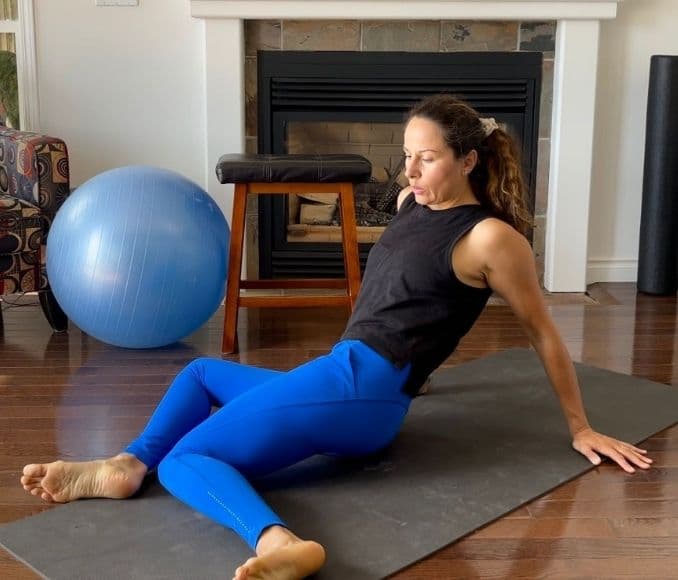 |
Start with 1 set of 5 repetitions on each side.
Progression 2: Lying Down
Begin by lying on your back on the floor with your knees bent and your feet flat on the floor, wider than hip-width apart. Slowly lower both knees to the floor on one-sided. Return to the starting position and repeat the movement on the opposite side. You should feel this dynamic stretch throughout the front of your hips. It is normal for one side to feel tighter than the other, and your knees might not lower all the way to the floor on both sides.
 |
 |
 |
Start with 1 set of 5 repetitions on each side.
Progression 3: Lying Down with Leg Assist
Begin by lying on your back on the floor with your knees bent and your feet flat on the floor, wider than hip-width apart. Slowly lower both knees to the floor on one-sided. At the bottom position, place the foot of your bottom leg on top of your opposite leg, and press down to deepen the stretch. Hold this position for several seconds. Return to the starting position and repeat the movement on the opposite side.
 |
 |
 |
 |
Start with 1 set of 5 repetitions on each side.
2. Foam Roller Supported Hip Stretch
If you do not have a foam roller, try using a rolled-up towel to complete this exercise. Prior to performing this stretch, it helps to warm up your quads and hip muscles with the foam roller.
Begin in an upright kneeling position with the foam roller lying in front of your knees. Take a big step forward with one foot, stepping over the roller and planting your foot on the floor in front of your body. Position the foam roller slightly above your knee joint on your back leg, supporting the weight of your body, and flex your back foot to stack your ankle over your toes. Engage your core and shift your hips forward slightly to sit your upper body upright. Place your hands on your hips or on your knee for support. Maintain good alignment in your upper body. You should feel the stretch along the front of your hip and thigh area. Hold this position for 10 – 15 seconds. Repeat the movement on the opposite side. To deepen the stretch, engage your glute muscles throughout the duration of the stretch.
 |
 |
Start with 1 set of 1 repetition on each side, holding for 10 – 15 seconds
Progression – Foam Roller Supported Hip Stretch with Reach
Begin in an upright kneeling position with the foam roller lying in front of your knees. Take a big step forward with one foot, stepping over the roller and planting your foot on the floor in front of your body. Position the foam roller above your knee joint on your back leg, supporting the weight of your body, and stack your back ankle over your toes. Engage your core and shift your hips forward slightly to sit your upper body upright. Maintain good alignment in your upper body. On the side of your bent knee, place your hand on your hip, then raise your opposite arm overhead. Reach over to the side, hold for 1 – 2 seconds, then raise back up to the center position. Repeat this movement several times. Repeat this exercise on the opposite side.
 |
 |
 |
 |

Start with 1 set of 5 repetitions on each side.
3. Foam Roller Hip Stretch
Begin by lying on your back on the floor with your knees bent and your feet flat on the floor. Position the foam roller under your sacrum (where your lower back meets your tailbone). Engage your core, straighten one leg, and use your hands to pull your bent knee up towards your chest. Hold this position for 10 – 15 seconds. Lower your bent leg to the floor and repeat the movement on the opposite side.
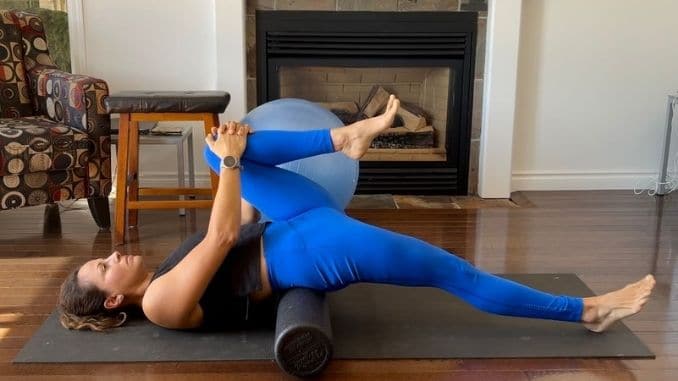 |
 |
Start with 1 set of 1 repetition on each side, holding for 10 – 15 seconds.
Progression – Foam Roller Hip Stretch with Leg Drop
Begin by lying on your back on the floor with your knees bent and your feet flat on the floor. Position the foam roller under your sacrum (where your lower back meets your tailbone). Engage your core, straighten one leg, and use your hands to pull your bent knee up towards your chest. Open up your hips and rotate your bent leg out to the side, using your hand to deepen the stretch. Return to the center position. Rotate your lower body to pull your bent knee over your straight leg and use your hand to pull your knee further downward to intensify the stretch. Hold this position for 10 – 15 seconds. Return to the center position and repeat the movement on the opposite side.
 |
 |
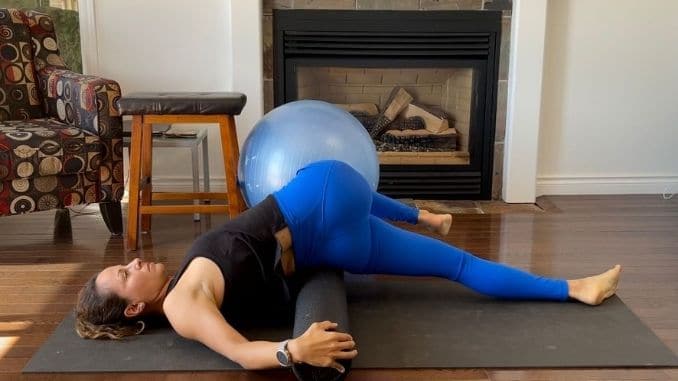 |
 |
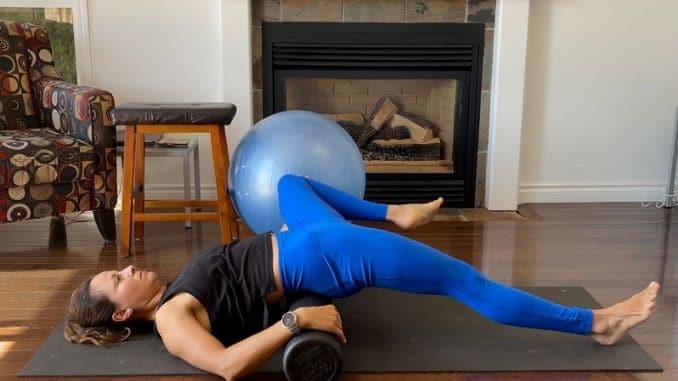 |
 |
Start with 1 set of 1 repetition on each side, holding for 10 – 15 seconds.
4. Stability Ball Psoas Release
For this exercise, we recommend placing a stable chair or table beside your stability ball to help with balance.
Begin in an upright standing position with the stability ball on the floor in front of you. Take a big step forward with one foot and position the ball between your split legs. Place one hand on a chair for balance as you shift your hips forward, bending your front leg and extending your back leg behind you. Flex your back foot and stack your ankle over your toes. Engage your core, keeping your upper body upright and your spine long. Hold this position for 10 – 15 seconds. Return to the starting position and repeat the movement on the opposite side.
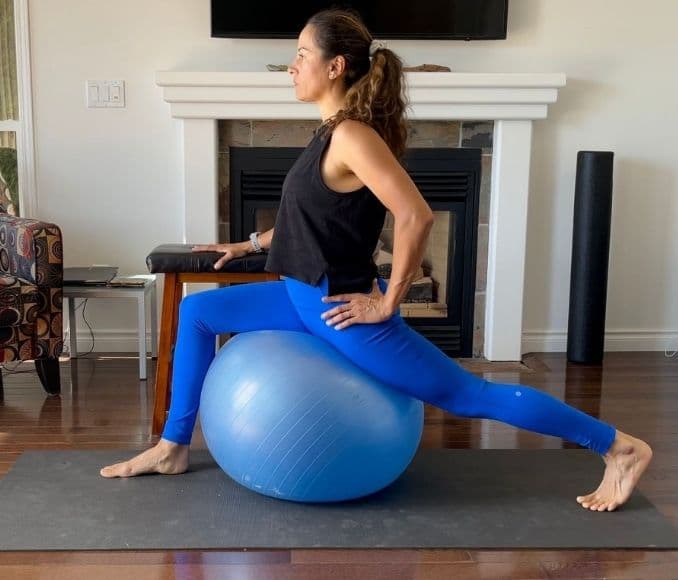 |
 |
Start with 1 set of 1 repetition on each side, holding for 10 – 15 seconds.
Progression – Stability Ball Psoas Release with Reach
Begin in an upright standing position with the stability ball on the floor in front of you. Take a big step forward with one foot and position the ball between your split legs. Place one hand on a chair for balance as you shift your hips forward, bending your front leg and extending your back leg behind you. Flex your back foot and stack your ankle over your toes. Engage your core, raise your opposite arm overhead and reach over to the side. Hold for 1 – 2 seconds, then raise back up to the center position. Repeat this movement several times. Repeat this exercise on the opposite side.
 |
 |
 |
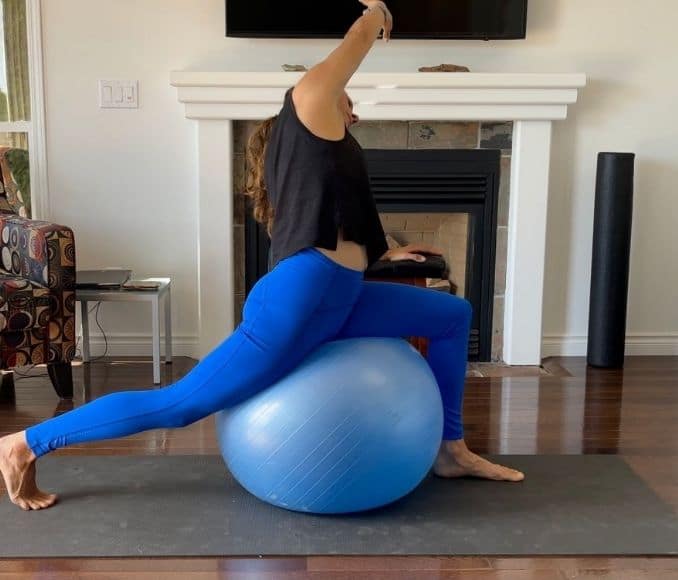 |
Start with 1 set of 1 repetition on each side, holding for 10 – 15 seconds.
Remember, none of these stretches should be painful. Listen to your body and only move as deeply into a stretch as you are able. Modify the movement as needed and only progress once the current variation of the stretch has become too easy. We also recommend foam rolling your hips and quads throughout the routine to keep your muscles warm and pliable. Adding these simple stretches to your daily routine is essential for optimal hip health.
For ultimate hip relief, try the absolute best program available today. Click here to unlock your hip flexors, once and for all.





